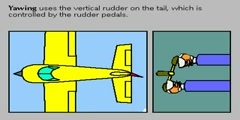Lec 13 - Acceleration of Aircraft Carrier Takeoff
Acceleration of Aircraft Carrier Takeoff Using what we know about takeoff velocity and runway length to determine acceleration
Video is embedded from external source so embedding is not available.
Video is embedded from external source so download is not available.
Channels: Physics (General)
Tags: Acceleration of Aircraft Carrier Takeoff
Uploaded by: khanphysics ( Send Message ) on 08-09-2012.
Duration: 14m 16s
Here is the next lecture for this course
Controlling an Aircraft
00:40 | 5404 viewsAcceleration due to gravity
00:47 | 7141 viewsLec 1 - MIT 16.885J Aircraft Systems Engi ...
01:50:18 | 2818 viewsLec 2 - MIT 16.885J Aircraft Systems Engi ...
01:50:22 | 2590 viewsLec 3 - MIT 16.885J Aircraft Systems Engi ...
01:51:36 | 3009 viewsLec 4 - MIT 16.885J Aircraft Systems Engi ...
01:52:51 | 2626 viewsLec 5 - MIT 16.885J Aircraft Systems Engi ...
01:57:46 | 2739 viewsLec 6 - MIT 16.885J Aircraft Systems Engi ...
01:59:51 | 2396 viewsLec 7 - MIT 16.885J Aircraft Systems Engi ...
01:50:22 | 2226 viewsLec 8 - MIT 16.885J Aircraft Systems Engi ...
01:53:26 | 2232 viewsLec 9 - MIT 16.885J Aircraft Systems Engi ...
01:51:14 | 2878 viewsLec 10 - MIT 16.885J Aircraft Systems Eng ...
01:03:02 | 2254 viewsLec 11 - MIT 16.885J Aircraft Systems Eng ...
01:53:07 | 2342 viewsLec 12 - MIT 16.885J Aircraft Systems Eng ...
01:55:27 | 2294 viewsLec 13 - MIT 16.885J Aircraft Systems Eng ...
01:52:26 | 2187 viewsNo content is added to this lecture.
This video is a part of a lecture series from of khan
Lecture list for this course
Lec 1 - Introduction to Vectors and Scalars
Lec 2 - Calculating Average Velocity or Speed
Lec 4 - Displacement from Time and Velocity Example
Lec 6 - Newton's First Law of Motion
Lec 7 - Newton's Second Law of Motion
Lec 8 - Newton's Third Law of Motion
Lec 9 - Airbus A380 Take-off Time
Lec 10 - Airbus A380 Take-off Distance
Lec 11 - Why Distance is Area under Velocity-Time Line
Lec 12 - Average Velocity for Constant Acceleration
Lec 14 - Race Cars with Constant Speed Around Curve
Lec 15 - Introduction to Gravity
Lec 16 - Mass and Weight Clarification
Lec 17 - Gravity for Astronauts in Orbit
Lec 18 - Would a Brick or Feather Fall Faster
Lec 19 - Deriving Displacement as a Function of Time, Acceleration and Initial Velocity
Lec 20 - Plotting Projectile Displacement, Acceleration, and Velocity
Lec 21 - Projectile Height Given Time
Lec 22 - Deriving Max Projectile Displacement Given Time
Lec 23 - Impact Velocity From Given Height
Lec 24 - Visualizing Vectors in 2 Dimensions
Lec 25 - Projectile at an Angle
Lec 26 - Different Way to Determine Time in Air
Lec 27 - Launching and Landing on Different Elevations
Lec 28 - Total Displacement for Projectile
Lec 29 - Total Final Velocity for Projectile
Lec 30 - Correction to Total Final Velocity for Projectile
Lec 31 - Projectile on an Incline
Lec 32 - Unit Vectors and Engineering Notation
Lec 33 - Clearing the Green Monster at Fenway
Lec 34 - Green Monster at Fenway Part 2
Lec 35 - Optimal angle for a projectile part 1
Lec 36 - Optimal angle for a projectile part 2 - Hangtime
How to Find the Optimal Angle for a Projectile Using Calculus Part 4
Lec 39 - Normal Force and Contact Force
Lec 40 - Normal Force in an Elevator
Lec 41 - IInclined Plane Force Componentsnclined Plane Force Components
Lec 42 - Ice Accelerating Down an Incline
Force of Friction Keeping the Block Stationary
Lec 44 - Correction to Force of Friction Keeping the Block Stationary
Lec 45 - Force of Friction Keeping Velocity Constant
Lec 46 - Intuition on Static and Kinetic Friction Comparisons
Lec 47 - Static and Kinetic Friction Example
Lec 48 - Introduction to Tension
Lec 50 - Tension in an accelerating system and pie in the face
Lec 51 - Moving pulley problem (part 1)
Lec 52 - Moving pulley problem (part 2)
Lec 53 - Introduction to Momentum
Lec 54 - Momentum: Ice skater throws a ball
Lec 55 - 2-dimensional momentum problem
Lec 56 - 2-dimensional momentum problem (part 2)
Lec 57 - Introduction to work and energy
Lec 58 - Work and Energy (part 2)
Lec 59 - Conservation of Energy
Lec 60 - Work/Energy problem with Friction
Lec 61 - Introduction to mechanical advantage
Lec 62 - Mechanical Advantage (part 2)
Lec 63 - Mechanical Advantage (part 3)
Lec 65 - Introduction to Torque
Lec 69 - Unit Vector Notation (part 2)
Lec 70 - Projectile Motion with Unit Vectors
Lec 71 - Projectile Motion with Unit Vectors (part 2)
Lec 72 - Projectile Motion with Ordered Set Notation
Lec 73 - Centripetal Force and Acceleration Intuition
Lec 74 - Visual Understanding of Centripetal Acceleration Formula
Lec 75 - Relationship between angular velocity and speed
Lec 76 - Calculus proof of centripetal acceleration formula
Lec 77 - Loop De Loop Question
Lec 78 - Loop De Loop Answer part 1
Lec 79 - Loop De Loop Answer part 2
Lec 80 - Acceleration Due to Gravity at the Space Station
Lec 81 - Space Station Speed in Orbit
Lec 82 - Conservation of angular momemtum
Lec 83 - Introduction to Newton's Law of Gravitation
Lec 85 - Intro to springs and Hooke's Law
Lec 86 - Potential energy stored in a spring
Lec 87 - Spring potential energy example (mistake in math)
Lec 88 - Introduction to Harmonic Motion
Lec 89 - Harmonic Motion Part 2 (calculus)
















